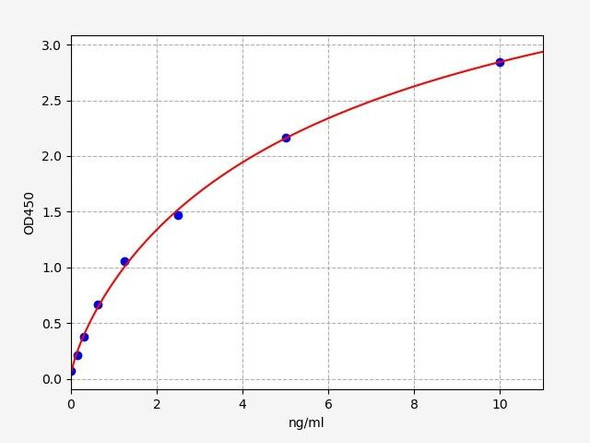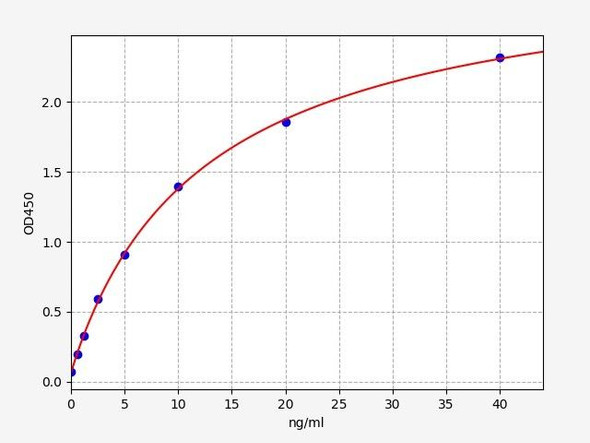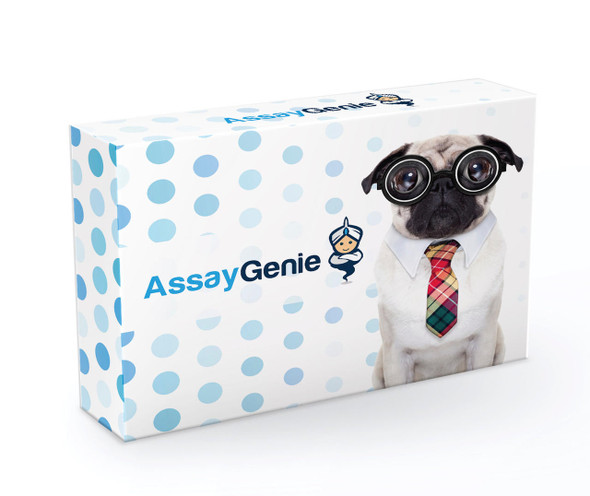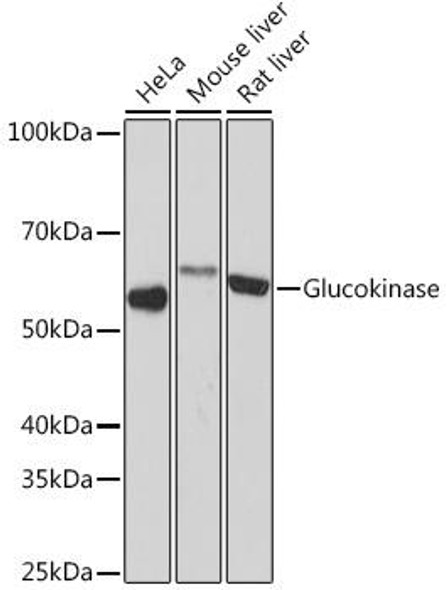Mouse Glucokinase (Gck) ELISA Kit (MOEB0522)
- SKU:
- MOEB0522
- Product Type:
- ELISA Kit
- Size:
- 96 Assays
- Uniprot:
- P52792
- Range:
- 78-5000 pg/mL
- ELISA Type:
- Sandwich
- Synonyms:
- Gck, Glucokinase, FGQTL3, GLK, Hexokinase-4, Hexokinase-D, HHF3, HK4, HXKP, LGLK, GK, glucokinase, hexokinase 4, HKIV, maturity onset diabetes of the young 2, MODY2
- Reactivity:
- Mouse
Description
Mouse Glucokinase (Gck) ELISA Kit
The Mouse Glucokinase (GCK) ELISA Kit is specifically designed for the quantitative detection of GCK levels in mouse serum, plasma, and cell lysates. This kit offers high sensitivity and specificity, guaranteeing accurate and consistent results for various research applications.Glucokinase is an important enzyme that plays a central role in glucose metabolism by regulating glucose uptake and utilization in the liver and pancreas. Dysregulation of GCK has been associated with various metabolic disorders such as diabetes and obesity, making it a valuable target for studying these conditions and developing new therapeutic interventions.
With its easy-to-use protocol and reliable performance, the Mouse GCK ELISA Kit is an essential tool for researchers looking to investigate the role of GCK in metabolic diseases and explore potential treatment options. Order yours today and accelerate your research progress.
| Product Name: | Mouse Glucokinase (Gck) ELISA Kit |
| SKU: | MOEB0522 |
| Size: | 96T |
| Target: | Mouse Glucokinase (Gck) |
| Synonyms: | Glucokinase, Hexokinase type IV, Hexokinase-D, HK IV, HK4, Gk |
| Assay Type: | Sandwich |
| Detection Method: | ELISA |
| Reactivity: | Mouse |
| Detection Range: | 78-5000pg/mL |
| Sensitivity: | 39.8pg/mL |
| Intra CV: | 8.3% | ||||||||||||||||||||
| Inter CV: | 9.6% | ||||||||||||||||||||
| Linearity: |
| ||||||||||||||||||||
| Recovery: |
| ||||||||||||||||||||
| Function: | Catalyzes the phosphorylation of hexose, such as D-glucose, D-fructose and D-mannose, to hexose 6-phosphate (D-glucose 6-phosphate, D-fructose 6-phosphate and D-mannose 6-phosphate, respectively) (PubMed:8530440). Compared to other hexokinases, has a weak affinity for D-glucose, and is effective only when glucose is abundant (By similarity). Mainly expressed in pancreatic beta cells and the liver and constitutes a rate-limiting step in glucose metabolism in these tissues (PubMed:8530440, PubMed:9867845). Since insulin secretion parallels glucose metabolism and the low glucose affinity of GCK ensures that it can change its enzymatic activity within the physiological range of glucose concentrations, GCK acts as a glucose sensor in the pancreatic beta cell (PubMed:8530440, PubMed:9867845). In pancreas, plays an important role in modulating insulin secretion (PubMed:8530440). In liver, helps to facilitate the uptake and conversion of glucose by acting as an insulin-sensitive determinant of hepatic glucose usage (PubMed:9867845). Required to provide D-glucose 6-phosphate for the synthesis of glycogen (PubMed:9867845). Mediates the initial step of glycolysis by catalyzing phosphorylation of D-glucose to D-glucose 6-phosphate (By similarity). |
| Uniprot: | P52792 |
| Sample Type: | Serum, plasma, tissue homogenates, cell culture supernates and other biological fluids |
| Specificity: | Natural and recombinant mouse Hexokinase-4 |
| Sub Unit: | Monomer (By similarity). Interacts with MIDN; the interaction occurs preferentially at low glucose levels and results in inhibition of hexokinase activity (By similarity). Interacts with GCKR; leading to sequestration in the nucleus (PubMed:10713097). |
| Research Area: | Metabolism |
| Subcellular Location: | Cytoplasm Nucleus Mitochondrion Under low glucose concentrations, GCK associates with GCKR and the inactive complex is recruited to the hepatocyte nucleus. |
| Storage: | Please see kit components below for exact storage details |
| Note: | For research use only |
| UniProt Protein Function: | GK: a glycolytic enzyme that catalyzes glucose metabolism in the liver and pancreatic beta cells. Acts as a ""glucose sensor"" in beta cells. The first and rate-limiting step in glycosis, a pathway that produces energy in the form of ATP from glucose. Glucokinase traps glucose inside the cell by catalyzing its phosphorylation to produce glucose-6-phosphate. Has a lower affinity for glucose than the three other isozymes of hexokinase, allowing other organs such as the brain and muscles to have first call on glucose when its supply is limited. Unlike other hexokinases, glucokinase is not inhibited by glucose-6-phosphate. Glucokinase is found in the outer membrane compartment of mitochondria. May bind VDAC, suppressing mitochondrial function. Glucokinase transcription is induced by insulin, perhaps via the activation of Stat 5B. Mutant glucokinase causes a rare form of diabetes and may also play a role in type 2 diabetes. Three splice variant isoforms of human glucokinase have been described. |
| UniProt Protein Details: | Protein type:Carbohydrate Metabolism - amino sugar and nucleotide sugar; Kinase, other; Carbohydrate Metabolism - galactose; Mitochondrial; Carbohydrate Metabolism - glycolysis and gluconeogenesis; EC 2.7.1.2; Carbohydrate Metabolism - starch and sucrose Cellular Component: nucleoplasm; mitochondrion; cell; cytoplasm; actin filament; cell cortex; cytosol; basal cortex; nucleus; secretory granule Molecular Function:transferase activity; hexokinase activity; protein binding; magnesium ion binding; nucleotide binding; kinase activity; ADP binding; phosphotransferase activity, alcohol group as acceptor; glucokinase activity; protein phosphatase binding; ATP binding; glucose binding Biological Process: positive regulation of glycogen biosynthetic process; glucose 6-phosphate metabolic process; lipid homeostasis; glucose homeostasis; NADP metabolic process; cellular response to glucose starvation; elevation of cytosolic calcium ion concentration; detection of glucose; negative regulation of gluconeogenesis; second-messenger-mediated signaling; glycogen biosynthetic process; glycolysis; regulation of potassium ion transport; glucose metabolic process; positive regulation of insulin secretion; fructose 2,6-bisphosphate metabolic process; cellular response to insulin stimulus; carbohydrate metabolic process; carbohydrate phosphorylation; positive regulation of glycolysis; negative regulation of epinephrine secretion; cell glucose homeostasis; regulation of insulin secretion; phosphorylation; positive regulation of phosphorylation |
| UniProt Code: | P52792 |
| NCBI GenInfo Identifier: | 31982798 |
| NCBI Gene ID: | 103988 |
| NCBI Accession: | NP_034422.2 |
| UniProt Secondary Accession: | P52792,P52791, |
| UniProt Related Accession: | P52792 |
| Molecular Weight: | 52,089 Da |
| NCBI Full Name: | glucokinase |
| NCBI Synonym Full Names: | glucokinase |
| NCBI Official Symbol: | Gck |
| NCBI Official Synonym Symbols: | Gk; GLK; HK4; HKIV; HXKP; MODY2; Gls006 |
| NCBI Protein Information: | glucokinase; HK IV; hexokinase 4; hexokinase-4; hexokinase-D; hexokinase type IV |
| UniProt Protein Name: | Glucokinase |
| UniProt Synonym Protein Names: | Hexokinase type IV; HK IV; Hexokinase-4; HK4; Hexokinase-D |
| Protein Family: | Glucokinase |
| UniProt Gene Name: | Gck |
| UniProt Entry Name: | HXK4_MOUSE |
| Component | Quantity (96 Assays) | Storage |
| ELISA Microplate (Dismountable) | 8×12 strips | -20°C |
| Lyophilized Standard | 2 | -20°C |
| Sample Diluent | 20ml | -20°C |
| Assay Diluent A | 10mL | -20°C |
| Assay Diluent B | 10mL | -20°C |
| Detection Reagent A | 120µL | -20°C |
| Detection Reagent B | 120µL | -20°C |
| Wash Buffer | 30mL | 4°C |
| Substrate | 10mL | 4°C |
| Stop Solution | 10mL | 4°C |
| Plate Sealer | 5 | - |
Other materials and equipment required:
- Microplate reader with 450 nm wavelength filter
- Multichannel Pipette, Pipette, microcentrifuge tubes and disposable pipette tips
- Incubator
- Deionized or distilled water
- Absorbent paper
- Buffer resevoir
*Note: The below protocol is a sample protocol. Protocols are specific to each batch/lot. For the correct instructions please follow the protocol included in your kit.
Allow all reagents to reach room temperature (Please do not dissolve the reagents at 37°C directly). All the reagents should be mixed thoroughly by gently swirling before pipetting. Avoid foaming. Keep appropriate numbers of strips for 1 experiment and remove extra strips from microtiter plate. Removed strips should be resealed and stored at -20°C until the kits expiry date. Prepare all reagents, working standards and samples as directed in the previous sections. Please predict the concentration before assaying. If values for these are not within the range of the standard curve, users must determine the optimal sample dilutions for their experiments. We recommend running all samples in duplicate.
| Step | |
| 1. | Add Sample: Add 100µL of Standard, Blank, or Sample per well. The blank well is added with Sample diluent. Solutions are added to the bottom of micro ELISA plate well, avoid inside wall touching and foaming as possible. Mix it gently. Cover the plate with sealer we provided. Incubate for 120 minutes at 37°C. |
| 2. | Remove the liquid from each well, don't wash. Add 100µL of Detection Reagent A working solution to each well. Cover with the Plate sealer. Gently tap the plate to ensure thorough mixing. Incubate for 1 hour at 37°C. Note: if Detection Reagent A appears cloudy warm to room temperature until solution is uniform. |
| 3. | Aspirate each well and wash, repeating the process three times. Wash by filling each well with Wash Buffer (approximately 400µL) (a squirt bottle, multi-channel pipette,manifold dispenser or automated washer are needed). Complete removal of liquid at each step is essential. After the last wash, completely remove remaining Wash Buffer by aspirating or decanting. Invert the plate and pat it against thick clean absorbent paper. |
| 4. | Add 100µL of Detection Reagent B working solution to each well. Cover with the Plate sealer. Incubate for 60 minutes at 37°C. |
| 5. | Repeat the wash process for five times as conducted in step 3. |
| 6. | Add 90µL of Substrate Solution to each well. Cover with a new Plate sealer and incubate for 10-20 minutes at 37°C. Protect the plate from light. The reaction time can be shortened or extended according to the actual color change, but this should not exceed more than 30 minutes. When apparent gradient appears in standard wells, user should terminatethe reaction. |
| 7. | Add 50µL of Stop Solution to each well. If color change does not appear uniform, gently tap the plate to ensure thorough mixing. |
| 8. | Determine the optical density (OD value) of each well at once, using a micro-plate reader set to 450 nm. User should open the micro-plate reader in advance, preheat the instrument, and set the testing parameters. |
| 9. | After experiment, store all reagents according to the specified storage temperature respectively until their expiry. |
When carrying out an ELISA assay it is important to prepare your samples in order to achieve the best possible results. Below we have a list of procedures for the preparation of samples for different sample types.
| Sample Type | Protocol |
| Serum | If using serum separator tubes, allow samples to clot for 30 minutes at room temperature. Centrifuge for 10 minutes at 1,000x g. Collect the serum fraction and assay promptly or aliquot and store the samples at -80°C. Avoid multiple freeze-thaw cycles. If serum separator tubes are not being used, allow samples to clot overnight at 2-8°C. Centrifuge for 10 minutes at 1,000x g. Remove serum and assay promptly or aliquot and store the samples at -80°C. Avoid multiple freeze-thaw cycles. |
| Plasma | Collect plasma using EDTA or heparin as an anticoagulant. Centrifuge samples at 4°C for 15 mins at 1000 × g within 30 mins of collection. Collect the plasma fraction and assay promptly or aliquot and store the samples at -80°C. Avoid multiple freeze-thaw cycles. Note: Over haemolysed samples are not suitable for use with this kit. |
| Urine & Cerebrospinal Fluid | Collect the urine (mid-stream) in a sterile container, centrifuge for 20 mins at 2000-3000 rpm. Remove supernatant and assay immediately. If any precipitation is detected, repeat the centrifugation step. A similar protocol can be used for cerebrospinal fluid. |
| Cell culture supernatant | Collect the cell culture media by pipette, followed by centrifugation at 4°C for 20 mins at 1500 rpm. Collect the clear supernatant and assay immediately. |
| Cell lysates | Solubilize cells in lysis buffer and allow to sit on ice for 30 minutes. Centrifuge tubes at 14,000 x g for 5 minutes to remove insoluble material. Aliquot the supernatant into a new tube and discard the remaining whole cell extract. Quantify total protein concentration using a total protein assay. Assay immediately or aliquot and store at ≤ -20 °C. |
| Tissue homogenates | The preparation of tissue homogenates will vary depending upon tissue type. Rinse tissue with 1X PBS to remove excess blood & homogenize in 20ml of 1X PBS (including protease inhibitors) and store overnight at ≤ -20°C. Two freeze-thaw cycles are required to break the cell membranes. To further disrupt the cell membranes you can sonicate the samples. Centrifuge homogenates for 5 mins at 5000xg. Remove the supernatant and assay immediately or aliquot and store at -20°C or -80°C. |
| Tissue lysates | Rinse tissue with PBS, cut into 1-2 mm pieces, and homogenize with a tissue homogenizer in PBS. Add an equal volume of RIPA buffer containing protease inhibitors and lyse tissues at room temperature for 30 minutes with gentle agitation. Centrifuge to remove debris. Quantify total protein concentration using a total protein assay. Assay immediately or aliquot and store at ≤ -20 °C. |
| Breast Milk | Collect milk samples and centrifuge at 10,000 x g for 60 min at 4°C. Aliquot the supernatant and assay. For long term use, store samples at -80°C. Minimize freeze/thaw cycles. |










